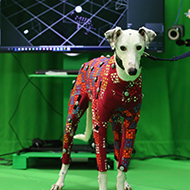
Method creates digital images of dogs without expensive equipment.
Researchers at the University of Bath have developed motion capture technology that could help vets diagnose lameness in dogs and monitor their recovery.
Widely-used in the entertainment industry, motion capture technology captures an actor's movements so that they can be turned into a 3D character on screen. The actor wears a suit covered in white markers, which are tracked by multiple cameras taking photographs from different angles.
Similar technology is also used by biomechanics experts to track the movement of elite athletes during training or to monitor rehabilitation from injuries. But this requires expensive equipment and dozens of white markers to be attached - especially when used with animals.
In this study, a team of computer scientists from CAMERA – the University of Bath's motion capture department - captured 3D information about dogs using a single RGBD camera. While normal digital cameras record the red, green and blue (RGB) colour in each pixel in an image, RGBD cameras also record the distance from the camera for each pixel.
The scientists used the technology to digitise the shape and movement of 14 different dog breeds wearing special 'doggie motion' capture suits. They then used the data to create a computer model that can accurately predict and replicate the poses of dogs that are not wearing a suit.
“This is the first time RGBD images have been used to track the motion of dogs using a single camera, which is much more affordable than traditional motion capture systems that require multiple cameras,” explained PhD researcher Sinéad Kearney. “This technology allows us to study the movement of animals, which is useful for applications such as detecting lameness in a dog and measuring its recovery over time."
She added that the research could also help the entertainment industry produce more authentic movement of virtual animals in films and video games. Dog owners may also be able to use it on their computers to make a 3D digital representation of their pets, she said.
The team has already tested the new method on computer-generated images of horses, cats, lions and gorillas, with promising results. Looking ahead, they hope to extend their animal dataset to make the results more accurate.
“While there is a great deal of research on automatic analysis of human motion without markers, the animal kingdom is often overlooked,” said Professor Darren Cosker, director of CAMERA.
“Our research is a step towards building accurate 3D models of animal motion along with technologies that allow us to very easily measure their movement. This has many exciting applications across a range of areas – from veterinary science to video games.”
Image (C) University of Bath.



 The RCVS has announced a new version of its 1CPD mobile app, with enhanced features for veterinary surgeons and veterinary nurses to record their continuing professional development.
The RCVS has announced a new version of its 1CPD mobile app, with enhanced features for veterinary surgeons and veterinary nurses to record their continuing professional development.